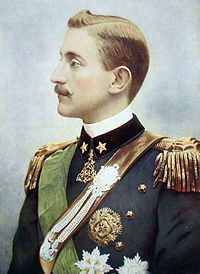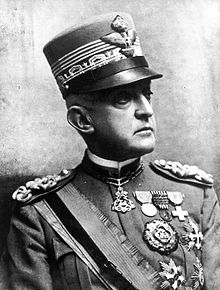Prince Emanuele Filiberto, Duke of Aosta
| Prince Emanuele Filiberto | |||||
|---|---|---|---|---|---|
| Duke of Aosta | |||||
 | |||||
| Duke of Aosta | |||||
| Predecessor | Prince Amedeo, 1st Duke | ||||
| Successor | Prince Amedeo, 3rd Duke | ||||
| Born | 13 January 1869 Genoa | ||||
| Died | 4 July 1931 (aged 62) Turin | ||||
| Burial | Cemetery of Redipuglia | ||||
| Spouse | Princess Hélène of Orléans | ||||
| Issue | Amedeo, 3rd Duke of Aosta Aimone, 4th Duke of Aosta | ||||
| |||||
| House | House of Savoy-Aosta | ||||
| Father | Amadeo I of Spain | ||||
| Mother | Maria Vittoria dal Pozzo della Cisterna | ||||
Emanuel Filibert of Aosta | |
|---|---|
 Emanuele Filiberto, as Army commander | |
| Nickname(s) | Undefeated Duke |
| Born | 13 January 1869 |
| Died | 4 July 1931 (aged 62) |
| Allegiance | |
| Service | |
| Rank | Marshal of Italy |
| Commands | Italian Third Army |
| Battles / wars | World War I |
Prince Emanuele Filiberto, 2nd Duke of Aosta (13 January 1869 – 4 July 1931) was an Italian general and member of the House of Savoy. He was Crown Prince of Spain from 1870 to 1873 and a cousin of Victor Emmanuel III of Italy. Filiberto was also commander of the undefeated Italian Third Army during World War I, which earned him the title of the "Undefeated Duke". After the war he became a Marshal of Italy.
Biography
He was born in Genoa the eldest son of Prince Amadeo of Savoy, Duke of Aosta and his first wife Donna Maria Vittoria dal Pozzo della Cisterna. In 1870 his father was elected king of Spain and Emanuele Filiberto became the Prince of Asturias. His time as heir apparent would be short lived as his father abdicated and returned to Italy in 1873 after three years on the throne. In 1890 he succeeded to the title of Duke of Aosta.
He began his career in the Italian Army at Naples, in 1905, as commander. During the First World War the Duke of Aosta commanded the Italian Third Army, which gained the nickname of Armata invitta ("undefeated army"). Following the war he was promoted to the rank of Marshal of Italy by Benito Mussolini in 1926.
Prince Emanuele Filiberto died in 1931 at Turin; accordingly to his will, he was buried in the military cemetery of Redipuglia, together with thousands of soldiers of the Third Army.
Entitled to him were the Duke of Aosta Bridge in Rome, built in 1942, and another on the Piave at Jesolo, inaugurated in 1927; a street in Rome; a cruiser of the Regia Marina was named after him, which was given to Soviet Union after World War II.
Family and children
He was married to Princess Hélène of Orléans (1871–1951). She was a daughter of Prince Philippe of Orléans and the Infanta Maria Isabel of Spain.
They had two sons:
- Amedeo, 3rd Duke of Aosta (21 October 1898 – 3 March 1942); married Princess Anne of Orléans.
- Aimone, 4th Duke of Aosta who briefly reigned as King Tomislav II of Croatia. (9 March 1900 – 29 January 1948); married Princess Irene of Greece and Denmark.
Honours and Awards
 United Kingdom : Knight of the Most Noble Order of the Garter - 15 July 1902[1]
United Kingdom : Knight of the Most Noble Order of the Garter - 15 July 1902[1]
Ancestry
| Family of Prince Emanuele Filiberto, Duke of Aosta | ||||||||||||||||||||||||||||||||||||||||||||||||||||||||||||||||||||||||||||||||||||||||||||||||||||||||||||||||||||||||||||||||||||||||||||||||||||||||||||||||||||||||||||||||||||||||||||||||||||||||||||||||||||||||||||||||||||||||||||||||||||||||||||||||||||||||||||||||||||||||||||||||||||||||||||||||||||||||||||||||||||||||||||||||||||||||||||||||||||||||||||||||||||||||||||||||||||||||||||||||||||||||||||||||||||||||||||||||||||||||||||||||||||||||||||||||||||||||||||||||||||||||||||||||||||||||||||||||||||||||||||||||||||||||||||||||||||||||||||||||||||||||||||||||||||||||||||||||
|---|---|---|---|---|---|---|---|---|---|---|---|---|---|---|---|---|---|---|---|---|---|---|---|---|---|---|---|---|---|---|---|---|---|---|---|---|---|---|---|---|---|---|---|---|---|---|---|---|---|---|---|---|---|---|---|---|---|---|---|---|---|---|---|---|---|---|---|---|---|---|---|---|---|---|---|---|---|---|---|---|---|---|---|---|---|---|---|---|---|---|---|---|---|---|---|---|---|---|---|---|---|---|---|---|---|---|---|---|---|---|---|---|---|---|---|---|---|---|---|---|---|---|---|---|---|---|---|---|---|---|---|---|---|---|---|---|---|---|---|---|---|---|---|---|---|---|---|---|---|---|---|---|---|---|---|---|---|---|---|---|---|---|---|---|---|---|---|---|---|---|---|---|---|---|---|---|---|---|---|---|---|---|---|---|---|---|---|---|---|---|---|---|---|---|---|---|---|---|---|---|---|---|---|---|---|---|---|---|---|---|---|---|---|---|---|---|---|---|---|---|---|---|---|---|---|---|---|---|---|---|---|---|---|---|---|---|---|---|---|---|---|---|---|---|---|---|---|---|---|---|---|---|---|---|---|---|---|---|---|---|---|---|---|---|---|---|---|---|---|---|---|---|---|---|---|---|---|---|---|---|---|---|---|---|---|---|---|---|---|---|---|---|---|---|---|---|---|---|---|---|---|---|---|---|---|---|---|---|---|---|---|---|---|---|---|---|---|---|---|---|---|---|---|---|---|---|---|---|---|---|---|---|---|---|---|---|---|---|---|---|---|---|---|---|---|---|---|---|---|---|---|---|---|---|---|---|---|---|---|---|---|---|---|---|---|---|---|---|---|---|---|---|---|---|---|---|---|---|---|---|---|---|---|---|---|---|---|---|---|---|---|---|---|---|---|---|---|---|---|---|---|---|---|---|---|---|---|---|---|---|---|---|---|---|---|---|---|---|---|---|---|---|---|---|---|---|---|---|---|---|---|---|---|---|---|---|---|---|---|---|---|---|---|---|---|---|---|---|---|---|---|---|---|---|---|---|---|---|---|---|---|---|---|---|---|---|---|---|---|---|---|---|---|---|---|---|---|---|---|---|---|---|---|---|---|---|---|---|---|---|---|---|---|---|---|---|---|---|---|---|---|---|---|---|---|---|---|---|---|---|---|---|---|---|---|---|---|---|---|---|---|---|---|---|---|---|---|---|---|---|---|---|---|---|---|---|---|---|---|---|---|---|---|---|---|---|---|---|---|---|---|---|---|---|---|---|---|---|---|---|---|---|---|---|---|---|---|---|---|---|---|---|---|---|---|---|---|---|---|---|---|---|---|---|---|---|---|---|---|---|---|---|
| ||||||||||||||||||||||||||||||||||||||||||||||||||||||||||||||||||||||||||||||||||||||||||||||||||||||||||||||||||||||||||||||||||||||||||||||||||||||||||||||||||||||||||||||||||||||||||||||||||||||||||||||||||||||||||||||||||||||||||||||||||||||||||||||||||||||||||||||||||||||||||||||||||||||||||||||||||||||||||||||||||||||||||||||||||||||||||||||||||||||||||||||||||||||||||||||||||||||||||||||||||||||||||||||||||||||||||||||||||||||||||||||||||||||||||||||||||||||||||||||||||||||||||||||||||||||||||||||||||||||||||||||||||||||||||||||||||||||||||||||||||||||||||||||||||||||||||||||||
References
- ^ "No. 27454". The London Gazette. 15 July 1902.
- Encyclopædia Britannica (1950)
External links

